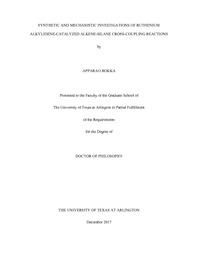
ATTENTION: The works hosted here are being migrated to a new repository that will consolidate resources, improve discoverability, and better show UTA's research impact on the global community. We will update authors as the migration progresses. Please see MavMatrix for more information.
Show simple item record
| dc.contributor.advisor | Jeon, Junha | |
| dc.creator | Bokka, Apparao | |
| dc.date.accessioned | 2018-02-15T20:29:39Z | |
| dc.date.available | 2018-02-15T20:29:39Z | |
| dc.date.created | 2017-12 | |
| dc.date.issued | 2017-12-18 | |
| dc.date.submitted | December 2017 | |
| dc.identifier.uri | http://hdl.handle.net/10106/27178 | |
| dc.description.abstract | Grubbs-type ruthenium alkylidene-catalyzed intramolecular alkene hydrosilylation and intermolecular dehydrogenative silylation and hydrosilylation of vinylarenes have been achieved with high regio- and stereoselectivity. Mechanistic details to support the initial activation of ruthenium complex have been revealed. Chapter 1 describes the uses of organosilanes in various fields. Development of transition metal-catalyzed hydrosilylations, alkene/alkyne metathesis activities of Grubbs-type ruthenium alkylidenes and non-metathetical activities including hydrosilylation of alkynes are discussed. The development of intramolecular hydrosilylation of alkenylsilyl ethers through reaction discovery and optimization is discussed. The strategy developed has been tested successfully on a variety of substrates with varying steric and electronic properties. A plausible mechanism is proposed for the activation of the ruthenium complex by direct σ-bond metathesis between Si-H and Ru-Cl. Specifically a mechanistic pathway for intramolecular alkene hydrosilylation catalyzed by ruthenium alkylidene complexes was proposed based on experimental observations from the optimization studies, isotope labelling studies, the investigation of base and halide effects. In Chapter 2, the synthesis and uses of vinyl and alkyl silanes and existing methods to synthesize vinylsilanes have been discussed. The discovery and development of dehydrogenative silylation and hydrosilylation of vinylarenes using Grubbs-type ruthenium alkylidene complexes are presented. Reaction optimization to selectively achieve the formation of vinyl and alkyl silanes by varying the L and X-type ligands has been demonstrated. Evaluation of sacrificial hydrogen acceptors (SHA) and the investigation on substrate scope for the dehydrogenative and hydrosilylation were explored. This chapter also rationalizes possible mechanistic pathways for dehydrogenative and hydrosilylation catalyzed by ruthenium alkylidene complexes varying L and X-type ligands. Mechanistic studies on isotope labelling experiments and ligand effect revealing the rate-determining step for both the transformations are discussed. | |
| dc.format.mimetype | application/pdf | |
| dc.language.iso | en_US | |
| dc.subject | Hydrosilylation | |
| dc.subject | Ruthenium alkylidenes | |
| dc.subject | Dehydrogenative silylation | |
| dc.subject | Alkenes | |
| dc.title | SYNTHETIC AND MECHANISTIC INVESTIGATIONS OF RUTHENIUM ALKYLIDENE-CATALYZED ALKENE-SILANE CROSS-COUPLING REACTIONS | |
| dc.type | Thesis | |
| dc.degree.department | Chemistry and Biochemistry | |
| dc.degree.name | Doctor of Philosophy in Chemistry | |
| dc.date.updated | 2018-02-15T20:30:43Z | |
| thesis.degree.department | Chemistry and Biochemistry | |
| thesis.degree.grantor | The University of Texas at Arlington | |
| thesis.degree.level | Doctoral | |
| thesis.degree.name | Doctor of Philosophy in Chemistry | |
| dc.type.material | text | |
| dc.creator.orcid | 0000-0003-3138-8178 | |
Files in this item
- Name:
- BOKKA-DISSERTATION-2017.pdf
- Size:
- 12.53Mb
- Format:
- PDF
This item appears in the following Collection(s)
Show simple item record


